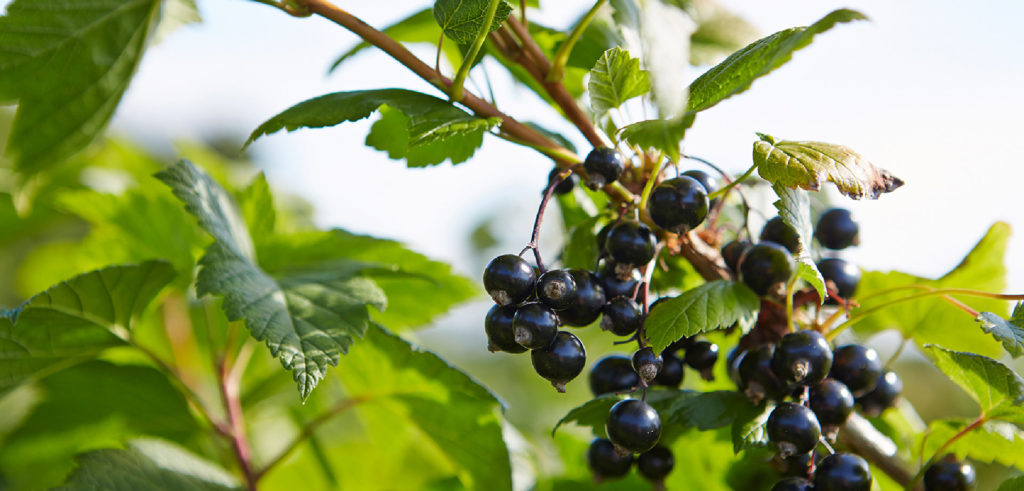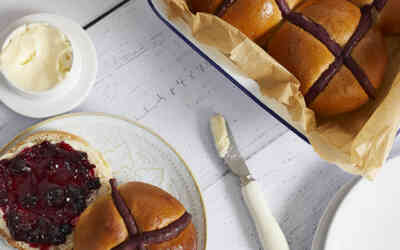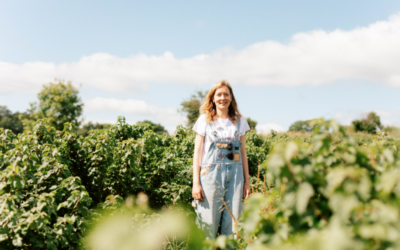Bush to Bottle: The Big Journey of the Small Blackcurrant

Did you know 90% of the UK’s blackcurrant crop is used to make Ribena? All blackcurrants are grown for their unique properties ranging from taste to climate resilience. It takes three years from planting a cutting until the blackcurrant bush is ready for its first harvest. Read on to discover the bush to bottle journey of the mighty blackcurrant…
Let’s Plant
Planting begins in the early months of the year when chilling time is at the optimum, as blackcurrant bushes love cold winters. Our 8” blackcurrant cuttings are planted by hand in rows 3m apart, they require a spacing of about 1.5m and will grow the same in height. When planting these cuttings, hearty soil, ample sunshine and a good feeding regime will make a big difference to the crop. So, although it will be three years before the bush will bear fruit, there is plenty to be getting on with in the meantime.
Time to Grow
As warm spring weather arrives, so does the green haze. This is when we see new growth on the plant’s woody frame. Whilst there is not much attention needed on the bushes themselves, our growers set to work in the fields to encourage beneficial bugs, bees and birds to thrive. You can find out more about the measures implemented to do so here.
As each year passes, bushes will need to be pruned to remove stems and allow for stronger ones to grow. By the third year, the bush will be strong enough to produce good quality fruit, suitable for Ribena!
Flowers!
The blackcurrant bushes will flower around May, as the weather begins to warm up. Our growers hold stock in an old rule of thumb, that the harvest will be exactly 92 days after the first blackcurrant flower blooms. Although this is a great guide for growers, by testing the sugar levels in the blackcurrants using a refractometer, they will know for sure if the bushes are ready for harvest.
Harvest Time
The great British blackcurrant harvest is short but sweet. Weather dependent, the harvest will usually begin in the South of the UK. Staggering out the harvest means we have a steady supply throughout the season and that our berries are always reaching their destination in tip-top condition.
Harvest will last until mid-August and is all carried out mechanically. Machine harvesters are used to shake the bushes and collect the berries, whist growers and their teams manually sort through blackcurrants to remove any debris.
Each load is weighed, quality checked and graded before collection the same day.
The Juicy Bit
The blackcurrants are then sent to be turned into juice within 24 hours of harvest. In a giant mill, they are washed, mashed and pressed before the juice is filtered, pasteurised and evaporated. At this stage, the fruit’s aromas are captured, these will be added back in at the bottling plant.
The majority of the year’s harvest supply of blackcurrant juice (1.5 million litres) is stored at Ribena’s factory in the cold store ready to be made into drinks and enjoyed by Ribena lovers in the UK and across the globe!
YOU MAY ALSO WANT TO READ
How to Celebrate Easter with Blackcurrants
Easter, and all the fun that comes with it, is just around the corner - think spring chicks, egg hunts, fields full of bouncy lambs, daffodils and, of course, fabulous feasts cooked on the barbecue whether the sun is shining or not! From delicious seasonal bakes to...
A Year As A Blackcurrant Grower
Looking to grow your own blackcurrants? If so, we’ve broken your blackcurrant-growing journey down into three simple steps and shared our top tips to see you from one start of the year to another… Planting Blackcurrant plants are typically sold as two-year-old bushes,...
A Year in Blackcurrant Recipes
YOU MAY ALSO WANT TO READ Every day’s a great day to enjoy blackcurrants, but we know the kind of dishes that will really hit the spot are those that tie into the seasons. From energy kicks to sweet treats, we’ve rounded up 12 of our blackcurrant recipes to...




